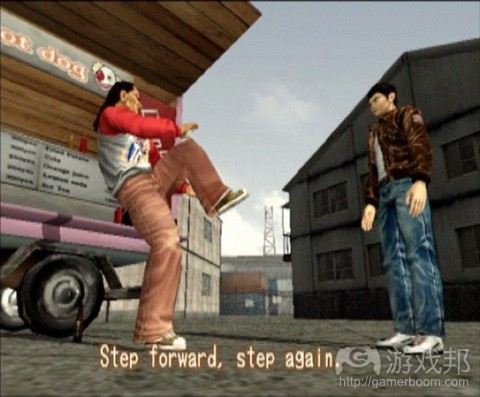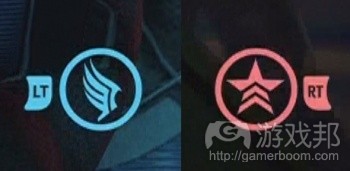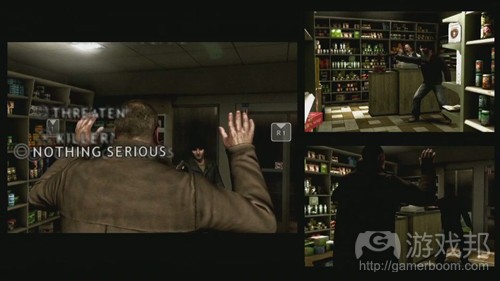QTE机制是游戏玩法和过场动画的纽带
作者:Cary Chichester
游戏玩法和过场动画通常处于相互排斥状态,一个提供交互体验,一个则带来被动体验。二者都呈现游戏娱乐活动的绝大多数内容。早期作品的表现方式非常薄弱,过场动画并没有像现在这么重要,所以从过场动画交互模式中受益最多的是《龙穴历险记》这类的互动电影,其中过场动画是娱乐活动的主要内容。
直到Dreamcast诞生,电子游戏才无需再通过预渲染连续镜头传递同电影一般的场景,所以让内容更具动态效果最后变成一种选项。此时Yu Suzuki带给我们的不仅是《莎木》,还有QTE(快速反应按键)。当此机制普遍出现在《莎木》、《战神》和《生化危机 4》时,其他游戏也开始广泛运用,如今它已变成众所周知的机制,是设计师们的得力助手。
随着此机制得到更广泛的运用,其中也伴随更多滥用情况,QTE的唯一目标似乎就是让所有内容更富趣味。此机制让过场动画更像玩法,让玩法更像过场动画,这似乎是所有开发者在滥用此机制前都清楚的事情。
我虽然认为QTE受到滥用,但目前关于此机制还没有所谓的“正确”和“错误”运用方式。不过我觉得运用QTE存在有效和无效之别,其中有效方式能够完全呈现机制的潜在魅力。虽然QTE的应用方式纷繁多样,但目前主要有3类呈现模式。其中2种属于无效方式,其QTE设置让玩法更像过场动画,而让过场动画更像玩法。
当运用“无效”,QTE将继续使过场动画和玩法设置脱节
首类呈现方式让QTE更像过场动画。此机制以很好的方式呈现游戏设置,让角色能够进行配合情境的操作(游戏邦注:这些是游戏常规机制所没有的内容)。此时QTE就像迷你游戏,其中体验就像独立于核心机制的游戏。这常被运用到《战神》之类的动作游戏中,尤其是当Kratos向敌人给出夺目的最后一击。
《战神》中的QTE根据Kratos应对的是常规敌人,还是boss会有所不同。当对抗的是常规敌人时,其QTE就非常简单,通常会配合后面的游戏设置,所以他会比如通过抓取按键适时根据情境袭击敌人。但若面对的是boss,QTE就会变成很多按键,玩家会发现它们在游戏中的前后操作差别很大。除不同于目前操作外,这些QTE进行攻击的方式也会发生改变;这让玩家看到按键的预置特性,随后他们会将自己的操作同“配合情境”联系起来,从而无法成功打败boss。这些QTE导致常规游戏设置和QTE玩法发生脱离,无法无缝隙地创造统一玩法体验。
呈现QTE的第二类方式让过场动画更像玩法。这体现在《猎天使魔女》和《火影忍术集》之类的游戏中,在这些游戏中,玩家清楚他们在同过场动画互动。由于这些QTE被用于调节过场动画,相比第一类QTE,随后的游戏内容更是同前面的操作严重脱节。此外,此脱节现象只会带来两种对比鲜明的玩法,而非统一体验。
若是运用方式有效,过场动画和玩法就不应存在差别,在QTE背景中,它们应融为一体。
第三类呈现方式通过创造强化既定玩法(游戏邦注:而不是让玩家从中脱离)的体验将游戏设置和过场动画有效联系起来。典型例子就是《质量效应 2》中的Paragon和Renegade环节,其中玩家能够通过好坏选项(在其弹出时候)打断过场动画。《质量效应》中的抉择是游戏趣味性的主要来源,这让玩家通过以对话轮形式呈现的若干选项改变故事内容。《质量效应》的QTE通过让影响在过场动画中呈现,达到强化此机制的目的。这些按键的执行方式不同于其他对话选择,因为它们属于定时按键,需要快速执行,但依然具有选择性,通过让玩家塑造故事,维持同其他对话选项相同的效果。
我最满意的QTE运用范例在于《莎木 II》。虽然这款游戏的QTE机制多种多样,从战斗情境中的扩充玩法到追逐情境中的互动过场动画,但其中总是存在一个非常突出的瞬间。其中有个情景是:Ryo拜访一位以前是武师的理发师,旨在向他学习经验。在教Ryo如何变得无所畏惧的过程中,他将刀片架到Ryo的脖子,告诉他不要动。这时,画面出现QTE,某按键迅速闪过屏幕,但玩家抑制住自己的本能,不去点击按键,让QTE通过,此情况试图让玩家抑制点击按键的本能反应(他们之前体验过的游戏已教导他们如何快速点击按键),这就会产生极为有趣的一幕——玩家在此获得前进的唯一方式就是不点击此按键。这是个被动情境,其中玩家的拒绝互动之举其实就是交互操作,让此既成为被动情境,同时也变成游戏的一部分。
巧妙运用QTE机制的另一款游戏是《Heavy Rain》,这是因为QTE呈现玩法和过场动画的绝大部分内容。几乎所有动作情境都通过QTE进行,玩法中的动作也是如此。QTE构成游戏体验的核心,开发者尝试以各种方式融入此机制。在某些情况中,QTE根据情境的紧张程度,理解难度也会发生变化,创造这样的新情境:玩家需要尝试把握他们的选项,做出相应衡量,在有限时间内做出反应。
不是所有游戏都能够有效运用QTE,所以这些能够通过其他方式创造娱乐体验的游戏自然从中受益良多。游戏中的QTE机制常颇引人反感不是因为机制本身不好,而是因为应用效果糟糕,这只会让玩家放弃他们最初追求的玩法。我们显然能够找到落实游戏QTE机制的新方式(游戏邦注:我们需要基于充分理由植入此机制,不要只是因为《战神》也这么做)。
此外,不要在战斗游戏中采用QTE机制,目前这是个规则。(本文为游戏邦/gamerboom.com编译,拒绝任何不保留版权的转载,如需转载请联系:游戏邦)
The Bridge Between Gameplay and Cutscenes: QTEs
by Cary Chichester
Gameplay and Cutscenes have often been at war with each other, with one providing an interactive experience and the other a passive one. They can both represent large portions of the entertainment in games, but the two forces have been kept separate for several decades. Early games had such weak presentation that cutscenes did not have as large an importance as they do today, so the games that benefited most towards making cutscenes interactive were interactive movies such as Dragon’s Lair where the cutscenes commanded a large portion of the entertainment.
It wasn’t until around the arrival of the Dreamcast that video games no longer need pre-rendered footage to deliver scenes that rivaled films, so making them more dynamic had finally become an option. This is when Yu Suzuki gave us not only Shenmue, but the term QTE (Quick Time Event). After the mechanic was popularized in games like Shenmue, God of War, and Resident Evil 4, its usage in other games dramatically increased to the point where it is now a well-known mechanic and aid for designers in their games.
As the mechanic saw more use, it also saw more misuse, and it really looked like the QTE’s only purpose was that it made everything more interesting. It made cutscenes more like gameplay and it made gameplay more like cutscenes, and it seems that’s all developers really needed to know before they found several different ways to abuse it.
Even as I say that QTEs have been misused, there isn’t currently a “right” and “wrong” way of using them. I would however consider that there are effective and ineffective methods of utilizing QTEs, where the effective methods fully display the engaging potential of the mechanic. While QTEs are implemented in many different ways, there are three categories that seem to represent how they are predominantly used in games today. Two of the three categories represent ineffective usages of QTEs, they are QTEs that make gameplay feel more like a cutscene and QTEs that make cutscenes feel more like gameplay.
When used “ineffectively” QTEs will maintain the disconnect between what is a cutscene and what is gameplay.
The first category represents QTEs that make gameplay feel more like a cutscene. These are used to give gameplay a cool presentation by allowing the character to perform context-sensitive actions that do not exist within the game’s normal mechanics. This is when the QTEs feel like a mini-game, where the experience feels like a game that is separate from the core mechanics. This is used often in many action games such as God of War when Kratos utilizes flashy finishers on his enemies.
The QTEs in God of War can differ depending on whether Kratos is dealing with a regular foe or a boss. When fighting regular foes his QTEs are simple and often fit with the rest of the gameplay, so he may for instance do a context-sensitive grab on an enemy using the grab button. When fighting bosses however, the QTEs become so elaborate with so many button presses that players see a stark contrast between what they’re doing during those QTEs and their actions during the rest of the game. In addition to the contrast of what they are doing, these QTEs are often mandatory to perform unlike the ones used on regular enemies; this leads the players to see the scripted nature of the event and subsequently associate their actions with “acting out a scene” rather than triumphantly beating a boss. These QTEs consequently create a disconnect between regular gameplay and QTE gameplay, rather than seamlessly creating one unified gameplay experience.
The second category represents QTEs that make cutscenes feel more like gameplay. These are used in games like Bayonetta and Ultimate Ninja Storm, where it is very apparent to the player that they are interacting with a cutscene. Because these QTEs are used to modify the cutscenes, there is a greater disconnect between the rest of the gameplay than the QTEs in the first category. Again, this disconnect only ends up creating two contrasting types of gameplay instead of one unified experience.
When used effectively there should not be a distinction between the cutscene and gameplay, in the context of the QTE they should be perceived as the same thing.
The third category represents QTEs that successfully link gameplay and cutscenes by creating experiences that enhances established gameplay rather than disconnects the player from it. A good example of this are the Paragon and Renegade moments in Mass Effect 2, where the player is able to interrupt cutscenes by performing good or evil options when prompted to on the screen. Making choices in Mass Effect represents a large portion of the enjoyment in the game by allowing the player to alter the story via several options that are usually presented in a dialogue wheel. The QTEs in Mass Effect enhance this mechanic by allowing the effect to happen within cutscenes. Their implementation is slightly different from other dialogue choices since they are timed events that must be performed quickly (see what I did there), but they remain completely optional and end up having the same effect as other conversation options by letting the player shape the story.
One of my favorite examples of QTE usage comes from Shenmue II. While the QTEs in that game range from extending gameplay in the fight scenes to interactive cutscenes in the chase scenes, there was at least one particular moment that always stood out. There was one scene where Ryo visited a barber who was formerly a martial arts master so that he could learn from him. In an effort to teach Ryo on how to be fearless, he held a razor blade to his neck and told him not to move at all. At this moment a QTE occurs and a button rapidly flashes on the screen, however the player must fight their instincts to press the button in order to pass the QTE. It managed to use the player’s own learned behavior against them; after spending two games teaching players how to quickly press a button to respond to a QTE, they were able to then use that conditioning to create this interesting scene where the only way to progress was to NOT press the button. It’s a passive scene where the player’s refusal to interact is in fact the interaction, making it both a passive scene and part of the game at the same time.
One game where you can find great implementations of QTEs would be Heavy Rain, as QTEs represent a large portion of both the gameplay and the cutscenes. Almost every action scene is handled through QTEs, and the same goes for the action in the gameplay. QTEs make up the core of the game’s experience and the developers managed to include various implementations of the mechanic. In some instances the QTEs become harder to read depending on how tense the situation is, creating a new experience where the player must attempt to read their options, weight them out, and react to them in a limited time.
Not every game can implement QTEs effectively, so it would probably benefit those games to find other methods of creating entertaining moments. The reason QTEs often get a lot of hate when put in games isn’t because the mechanic itself is bad, but rather it’s implementation has often been poor and it only distracts the player from the type of gameplay they really purchased the game for. We will undoubtedly find new ways to implemenet QTEs in games, we should just make sure that we’re doing it with good reason, and not just because God of War does it.
Oh yeah, also don’t use QTEs in fighting games. That’s a rule now.(Source:gamasutra)
下一篇:游戏设计需把握好故事的呈现力度











































 闽公网安备35020302001549号
闽公网安备35020302001549号